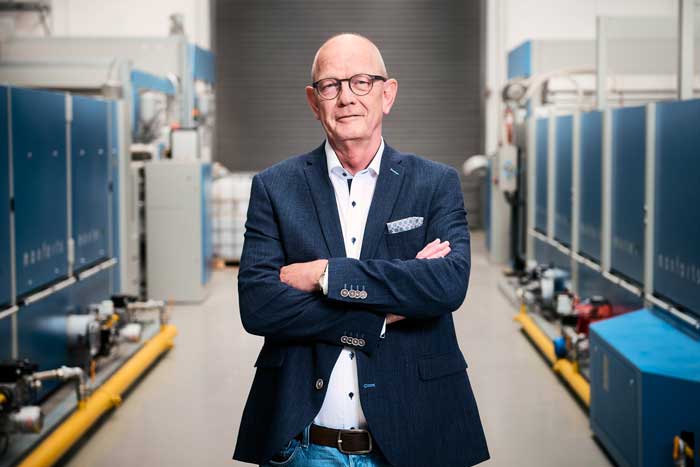
Monforts is constantly updating machines for resource efficiency
Monforts is a global supplier of textile machines and systems for the finishing and coating of woven and knitted goods as well as special applications. Almost one hundred agents represent Monforts in all textile centres around the world. Successful textile manufacturers worldwide have therefore been relying on systems from A. Monforts Textilmaschinen GmbH & Co. KG for over 135 years. Gunar Meyer, Managing Director, Monforts, in this conversation with Divya Shetty, explains why Germany is a leader in textiles and how his company is working to strengthen the relationship between the two countries.
Germany is renowned for its advanced technology and engineering. What would you say are the key strengths of the German textile machinery industry that set it apart from other countries?
German textile machinery is known for its precision engineering, ensuring high levels of accuracy in textile production. This precision leads to consistent quality, reducing waste and enhancing efficiency in manufacturing processes. Advanced automation and control systems further optimise production, to keep human error to a minimum and increase productivity. Alongside other members of the VDMA’s textile machinery association, Monforts prides itself on rapidly responding to market requests and the aftersales services that are provided to our customers worldwide.
Could you share some of the latest innovations Monforts has made in textile machinery?
The new coaTTex is our latest response to a demand from the market for a reliable coater that can be up and running very quickly, is easy to operate, and enables a wide range of performance properties to be imparted on fabrics extremely economically. For single-sided application with paste or foam, it is suitable for both incorporation into existing finishing ranges as well as installation with new Monforts lines, notably the industry-leading Montex stenter systems. A wide range of coatings can be applied to fabrics for providing functions such as waterproofing, liquid and gas protection and breathability, in addition to foam lamination and black-out coating.
Sustainability is becoming increasingly important in the textile industry. How does Monforts address environmental concerns through its machinery and processes?
We are constantly updating and improving our machines for resource efficiency. With the latest Montex stenters, for example, overall energy savings of up to 40 per cent can now be achieved compared to a conventional stenter with no heat recovery or energy optimisation measures. The retrofitting of specific modules with new control and drive technology – going far beyond the basic replacement of spare parts – can also have a significant impact on the performance of an existing line. This is especially the case in achieving further energy savings. The company’s universal Energy Tower, for example – a flexible, free-standing air/air heat exchanger for recovering the heat from the exhaust air flow of thermal processes – can result in an up to 30 per cent reduction in the energy consumed by a line, depending on the controlled exhaust air volume and operating temperature. The Monforts Eco Booster, which is now completely integrated into the chamber design of the latest Montex stenters, is another retrofitting option. This single state-of-the-art heat recovery system with automatic cleaning can be added to existing ranges of up to eight chambers to achieve significant energy savings.
The relationship between Germany and India in the textile sector has been growing. Can you elaborate on how Monforts is engaging with the Indian market and any collaborative projects or partnerships you are involved in?
India is a significant market for us, and we have developed long-standing relationships of mutual trust with many of the leading textile manufacturers, who appreciate our ongoing service programmes. As our representative in India, A.T.E. has proved the perfect partner in installing and commissioning Monforts machines, with its service team working side by side with our own engineers to ensure the machines fully meet every customer expectation. A.T.E. has also invested in the training of sales and service staff on Monforts technology.
How does Monforts ensure high standards of quality and precision in your machinery, and what measures are in place to maintain this reputation?
We have a strong team of experienced engineers and service technicians around the world and we are proud to have operated our Montex machine assembly site in Austria for more than 40 years, in order to continuously ensure high quality and reliability. We gain valuable feedback by working closely with both our network of national representatives and service centres, and of course, our customers.
Could you discuss any upcoming trends or technological advancements in textile machinery that you believe will shape the future of the industry?
Digitalisation and sustainability really go hand in hand for all textile technology companies nowadays. It is through digitalisation that further resource and machine efficiencies are being realised through complete control, not only of individual machines, but of synchronised and integrated lines and full manufacturing plants. At a time when energy prices continue to be extremely high for textile manufacturers virtually everywhere, we remain committed to our focus on faster, more efficient technologies that minimise the use of all resources. Monforts is also currently leading a consortium of industrial partners and universities in the three-year WasserSTOFF project to explore all aspects of green hydrogen as a fast-rising new industrial energy option. Green hydrogen’s potential as a clean fuel source is tremendous, but there is much we need to explore when considering its use in textile finishing processes. Everybody knows that textile finishing is a high energy consuming process and as a technology leader we are rising to the challenge of exploring alternative heating options to be ready for the future.




